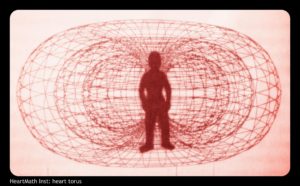
Boundaries. I love how the therapeutic community throws words like “boundaries” around, without a clear explanation. Before you read on, in fact, go ahead and test this (and for those of you who’ve had therapy, or at least read a multitude of self-help books, this should be especially fun). How would you describe boundaries? Are they:
- A concept of mental health determining, cognitively, what is appropriate and what is not.
- A “wall” that keeps out all those but whom you, very selectively, let in.
- A “wetsuit” that you can physically sense, that blocks energy.
- None of the above.
Years ago, I went to a workshop given by a physician, Joseph Chilton Pearce, who believed he succeeded in identifying and tracking an energy field that originated in the heart, extending out then down, looping back up to the place of origin. He based these on computer measurements taken by HeartMath and the University of Utah. These initial findings might be validation for what our ancestors and current shamanic healers in more natural societies understand as an essential component of healing, that our energy is as real as our matter.
I know, you think that next I’ll be telling you to use this energy to manifest a red Jaguar. Relax, I’m just asking you to consider doing another experiment now, and see for yourself. You’ll need a friend for this: first, get seated and grounded, as you need to be able to sense your body to start with. Then have your friend sit next to you, but not too close. An arm’s length away is good. Close your eyes. Have him/her slowly bring their hand close enough to touch you, and say “stop” right before you think they’ll make contact. Can you sense? If you can, do you think the explanation is more than just becoming aware of body heat or of a change in the light your closed eyes can still experience?
What you might consider, in the question above, is “d.” The traditional concept of boundaries is actually anti-therapeutic in the long run. After all, aren’t we hoping for more satisfying relationships with others? How can that be, if our “healthy” response to anyone new starts with “no?” Whether you agree with the energy model or not, imagine at least that there is a field of some sort around you. When someone, known or unknown, comes in contact with this field, this territory within your boundaries, you become alert to this new influence. You pick up information on a subtle level, either energetically, or if you prefer, through a multitude of “tells”—demeanor, facial expression, scent, small nervous movements or rigidity—that indicate whether you want to draw this person in closer (which will not happen if all you’ve got working for you is a wall) or go into protective mode.
After all, as Robert Frost declared: “there is something in one that does not love a wall.”
We know that healthy boundaries are crucial in recovering from trauma. Next week, I’ll deepen the discussion and provide an exercise that hopefully you can use to strengthen your energetic territory.
To read the core article, click here
To read the second part, click here

